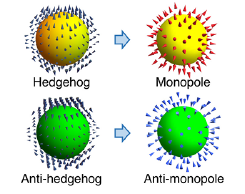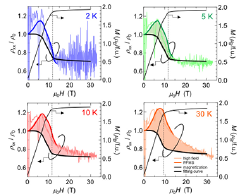Robustness of Emergent Monopole Fluctuations in a Chiral Magnet MnGe under High Magnetic Fields
N. Kanazawa, Y. Tokura, and M. Tokunaga
Topological spin textures are a fertile source of emergent electromagnetic responses owing to their quantized Berry phase. Berry phase acts as a fictitious magnetic flux, so-called an emergent magnetic flux, affecting the motion of conduction electrons in solids. By designing a topological spin arrangement, we can achieve an arbitrary emergent magnetic field distribution, whose magnitude may reach as large as 4000 T when the size of topological spin object is squeezed in 1-nm2 area. In addition to such possible gigantic electromagnetic responses, it is also noteworthy that we can effectively realize the magnetic monopole structures, where the magnetic field distribution is inversely proportional to the square of the distance (∝r/|r|3).

Fig. 1. Spin hedgehogs and corresponding monopole-type emergent field distributions.

Fig. 2. Longitudinal magneto-resistivity (MR) measured with use of mid-pulse magnet at low temperatures (T = 2, 5, 10, 30 K). Thick-line curves are the results obtained by steady-field measurements (PPMS) up to 14 T. Bold black curves are the estimated conventional MR associated with the variations of magnetization shown in the black thin lines.
In a chiral magnet MnGe, there realized three-dimensional hairy spin structures, so-called spin hedgehogs, which behave as the quantized sources or sinks of effective gauge field, that is, emergent monopoles and anti-monopoles (Fig. 1). In association with emergent-monopole motion driven by an external magnetic field, dramatic changes in magneto-transport properties appear, exhibiting unusual magnetic-field dependence, such as positive magneto-resistance, multiple elastic anomalies, magnetic-field-enhanced thermopower and so on [1]. Those unusual properties are rooted in large fluctuations of emergent monopoles, which induce considerable dynamical variations in the emergent magnetic field distribution and consequently cause intense scatterings of electrons, phonons and magnons.
By high-field measurements of magnetization and resistivity with use of the mid-pulse magnets installed at ISSP, we experimentally found that the emergent monopole fluctuations can survive far beyond the topological transition where the majority of spin hedgehogs undergo pair annihilation [2]. Figure 2 shows the magnetic field dependence of magnetization (M) and magneto-resistivity normalized by its zero-field value (ρxx/ρ0). We compare the measured ρxx/ρ0 (color lines in Fig. 2) with the ordinary contribution to ρxx/ρ0 from the alignment of spins (thicker black lines, estimations from the M-profiles), so as to evaluate the unusual contribution from the monopole fluctuations (color shades). While at the low temperatures (T = 2 K and 5 K) the unusual contribution only exists below the magnetic field Hc with the topological transition (vertical dashed lines), it persists even above Hc only with small temperature elevation above 10 K. This result may indicate the possibility that a part of spin hedgehogs escaping from their annihilation or thermally excited hedgehog-like spin structure may exist even in the high-field regime and their fluctuations cause strong scatterings of charge carriers. The observed robustness of the emergent monopole fluctuations possibly originates from topological protection against unwinding of the spin texture by external magnetic fields.
The present results not only open the door to veiled characteristic properties of emergent monopoles in the high-field regime but also demonstrate promising usefulness of high-field measurements to clarify the topological stability of spin nano-objects.
References
- [1] N. Kanazawa, Y. Nii, X.-X. Zhang, A. S. Mishchenko, G. De Filippis, F. Kagawa, Y. Iwasa, N. Nagaosa, and Y. Tokura, Nature Commun. 7, 11622 (2016).
- [2] Y. Fujishiro, N. Kanazawa, T. Shimojima, A. Nakamura, K. Ishizaka, T. Koretsune, R. Arita, A. Miyake, H. Mitamura, K. Akiba, M. Tokunaga, J. Shiogai, S. Kimura, S. Awaji, A. Tsukazaki, A. Kikkawa, Y. Taguchi, and Y. Tokura, Nature Commun. 9, 408 (2018).
